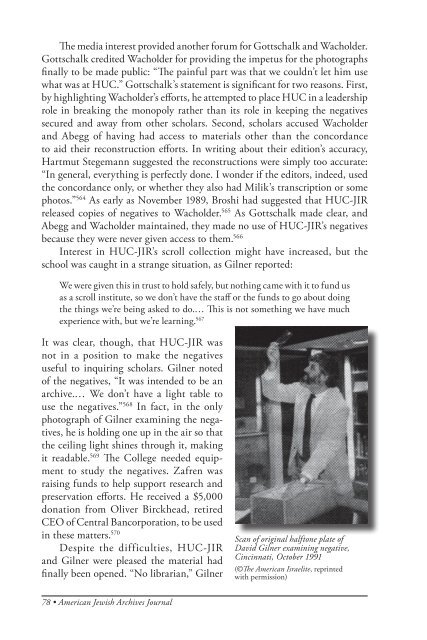The American Jewish Archives Journal, Volume LXI 2009, Number 1
The American Jewish Archives Journal, Volume LXI 2009, Number 1
The American Jewish Archives Journal, Volume LXI 2009, Number 1
Create successful ePaper yourself
Turn your PDF publications into a flip-book with our unique Google optimized e-Paper software.
<strong>The</strong> media interest provided another forum for Gottschalk and Wacholder.<br />
Gottschalk credited Wacholder for providing the impetus for the photographs<br />
finally to be made public: “<strong>The</strong> painful part was that we couldn’t let him use<br />
what was at HUC.” Gottschalk’s statement is significant for two reasons. First,<br />
by highlighting Wacholder’s efforts, he attempted to place HUC in a leadership<br />
role in breaking the monopoly rather than its role in keeping the negatives<br />
secured and away from other scholars. Second, scholars accused Wacholder<br />
and Abegg of having had access to materials other than the concordance<br />
to aid their reconstruction efforts. In writing about their edition’s accuracy,<br />
Hartmut Stegemann suggested the reconstructions were simply too accurate:<br />
“In general, everything is perfectly done. I wonder if the editors, indeed, used<br />
the concordance only, or whether they also had Milik’s transcription or some<br />
photos.” 564 As early as November 1989, Broshi had suggested that HUC-JIR<br />
released copies of negatives to Wacholder. 565 As Gottschalk made clear, and<br />
Abegg and Wacholder maintained, they made no use of HUC-JIR’s negatives<br />
because they were never given access to them. 566<br />
Interest in HUC-JIR’s scroll collection might have increased, but the<br />
school was caught in a strange situation, as Gilner reported:<br />
We were given this in trust to hold safely, but nothing came with it to fund us<br />
as a scroll institute, so we don’t have the staff or the funds to go about doing<br />
the things we’re being asked to do.… This is not something we have much<br />
experience with, but we’re learning. 567<br />
It was clear, though, that HUC-JIR was<br />
not in a position to make the negatives<br />
useful to inquiring scholars. Gilner noted<br />
of the negatives, “It was intended to be an<br />
archive.… We don’t have a light table to<br />
use the negatives.” 568 In fact, in the only<br />
photograph of Gilner examining the negatives,<br />
he is holding one up in the air so that<br />
the ceiling light shines through it, making<br />
it readable. 569 <strong>The</strong> College needed equipment<br />
to study the negatives. Zafren was<br />
raising funds to help support research and<br />
preservation efforts. He received a $5,000<br />
donation from Oliver Birckhead, retired<br />
CEO of Central Bancorporation, to be used<br />
in these matters. 570<br />
Despite the difficulties, HUC-JIR<br />
and Gilner were pleased the material had<br />
finally been opened. “No librarian,” Gilner<br />
78 • <strong>American</strong> <strong>Jewish</strong> <strong>Archives</strong> <strong>Journal</strong><br />
Scan of original halftone plate of<br />
David Gilner examining negative,<br />
Cincinnati, October 1991<br />
(©<strong>The</strong> <strong>American</strong> Israelite, reprinted<br />
with permission)

















